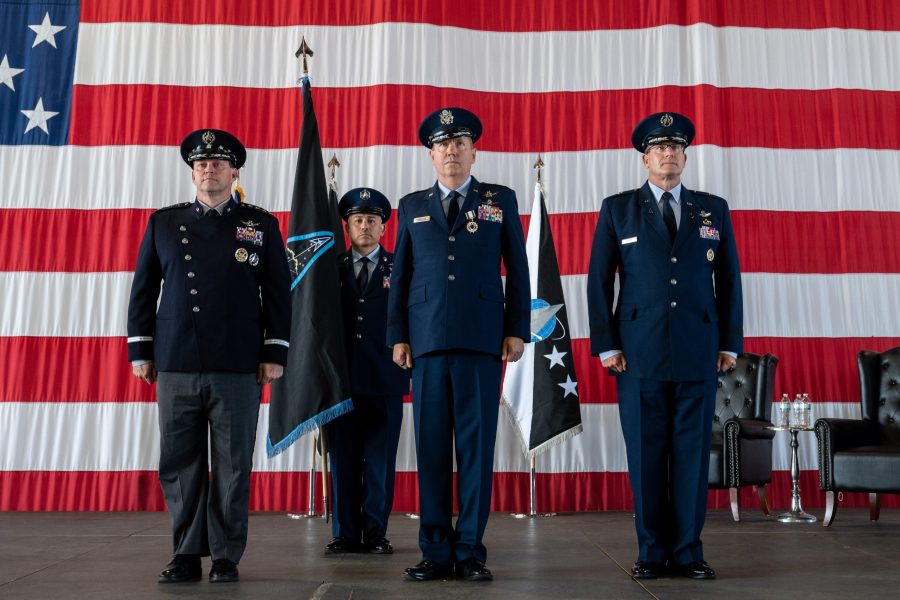
STARCOM Gets a New Commander at a ‘Hinge in Space Force History’ (Image Credit: airandspaceforces)
Brig. Gen. Timothy Sejba took over as the head of Space Training and Readiness Command on July 20, succeeding Maj. Gen. Shawn N. Bratton as the Space Force looks to upgrade its test and training infrastructure and develop new doctrine and tactics.
In a ceremony at Peterson Space Force Base, Colo., Chief of Space Operations Gen. B. Chance Saltzman called this moment a “hinge in Space Force history,” saying command of STARCOM is “a huge responsibility.”
“The challenges before us are immense,” Saltzman said. “But so too, are the opportunities. From advancing our technological prowess to enhancing our capabilities in the domain, we must remain at the cutting edge of innovation. Our ability to adapt, to stay ahead of emerging threats and seize new frontiers will be instrumental in maintaining our superiority in space. And that begins with our Guardians and the doctrine, testing, training, and education that STARCOM provides.”
Saltzman has emphasized test and training since his confirmation hearing to be CSO, telling lawmakers at the time that the Space Force needs simulators and testing ranges to ensure Guardians are practiced in operating space systems under stress, when adversaries are trying to jam or attack space capabilities. He has also called for developing new operational concepts and tactics.
STARCOM is at the forefront of Saltzman’s drive to field “resilient, ready, combat-credible forces.” Bratton outlined some of those efforts during a May webinar with the Mitchell Institute for Aerospace Studies, noting he wanted to shift away from traditional classroom learning for Guardians.
“Now the discussion is, ‘Why aren’t we flying a spacecraft in training? Why aren’t we getting some sort of reps and sets, some sorties in, in the training environment?’” Bratton said. “And that alleviates some of the training burden that we placed on the operational units.”
Bratton, who has been nominated for a third star to become deputy chief of space operations for strategy, plans, programs, and requirements, had a productive tenure at STARCOM. Under his leadership, STARCOM created a Space Force Basic Military Training curriculum and pioneered the Space Force’s unique approach to a War College, partnering with Johns Hopkins University for that kind of leader developmental education. STARCOM also stood up and expanded new exercises like Polaris Hammer and Black Skies.
The command also had a hand in culture: Under Bratton’s watch, STARCOM launched the USSF’s unique patching ritual, in which BMT graduates receive their first Space Force patch as a hand-me-down from a seasoned Guardian, along with a letter by that other Guardian to inspire the start of their Space Force careers.
“There are three things needed to set those conditions for culture,” Bratton said July 20. “One, the sense of joining an organization that is greater than yourself. Two, the sense of achievement by accomplishing something difficult. And three, the use of ceremony and ritual in positive ways. And we’ve done all three of those things for the Space Force.”
Bratton now awaits confirmation to his new post, along with some 250 other general and officers whose promotions are on hold, caught up in a political stand-off pitting Alabama Republican Sen. Tommy Tuberville against the Biden administration over a Defense Department policy that pays for travel and leave for members seeking abortion or other reproductive services not available where they are stationed.
He passed the guidon to Sejba, previously USSF’s program executive officer for battle management and command, control, and communications. Perhaps the biggest task on Sejba’s plate: Developing the the National Space Test and Training Complex (NSTTC), a collection of sensors and assets on the ground and in orbit that Guardians will use to try out new tactics and new systems.
At the same time, he’ll oversee a field command still in transition—the Department of the Air Force announced in June that it has selected Patrick Space Force Base, Fla., as the preferred location for STARCOM’s permanent headquarters, with the goal of moving there starting in the fall of 2024. That’s in addition to four of its five Deltas that still need to move to their permanent homes.
“We must continue to push, to increase our capacity and capability to field combat-ready forces,” Sejba told Guardians at the change of command ceremony. “This includes fully standing up the command and finalizing the basing of our Deltas. It also means delivering an operational test and training infrastructure that enables Guardians to test, train, and develop tactics in an operationally relevant environment to achieve full spectrum readiness.”
In the meantime, there will still be plenty to do, Bratton said. “There’s more doctrine to write, more exercises to host, more systems to test, classes to teach, more readiness to build,” he said. “There are always more Guardians to prepare.”








